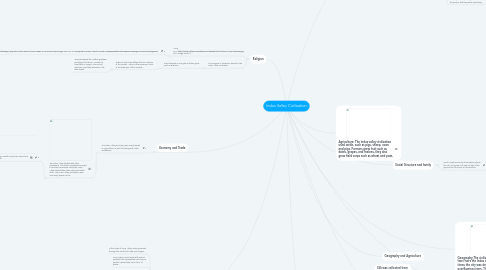
1. Rulers where made of Ivory or copper alloy. The ruler was the first developed by the Indus Valley Civilization.
2. Stepwells where used to store and collect water early in time. Evidence shows the earliest stepwells where created in Indus Valley.
3. Religion
3.1. <img src="http://indus-valley-civ.weebly.com/uploads/3/2/1/5/32151149/1506640.jpg" alt="Image result"/>
3.1.1. https://www.google.com/search?rlz=1CASMAE_enUS763US763&biw=1366&bih=630&tbm=isch&sa=1&q=hinduism+symbol&oq=hinduism+symbol&gs_l=psy-ab.3..0l4.13036.14763.0.15064.7.7.0.0.0.0.213.815.4j2j1.7.0....0...1.1.64.psy-ab..0.7.807...0i67k1.0.oSdVJWGZjH8&safe=active&ssui=on#imgrc=1maFMumcQgT5zM:
3.2. The origions of Hinduism started in the Indus Valley civilization
3.2.1. They believed in one god and their gods name is Brahman
3.2.1.1. Brahman has three different forms. Brahma is the creator. Vishnu is the preserver. Shiva is the destroyer of the universe.
3.2.1.1.1. They wroshiped the mother goddess worshiped lord shiva, Worship of trees faith in maigic, charms and sacrifices. Last they believed in life after death.
4. Economy and Trade
4.1. The Indus Valley economy was mainly based on agriculture, as well as trading with other civilizations.
4.1.1. The Indus Valley traded with other civilizations. The other civilizations brought in food and resources, while the Indus Valley traded them their pots and cotton cloth. The Indus Valley Civilization were commonly known as the
4.1.1.1. Most of their wealth came from wheat and cotton cloth.
4.1.1.1.1. The most important characteristic of the Indus Valley Civilization was based on trading, without it they would not survive as a Civilization.
4.1.1.1.2. http://downloads.bbc.co.uk/rmhttp/schools/primaryhistory/images/indus_valley/way_of_life//i_priest-king.jpg
5. Governments and Leaders
5.1. In the cities of Incus Valley rulers governed through the control of trade and religion.
5.2. Incan rulers carried seals with animal symbols that represented each animal symbol represented some form of power.
5.3. There is no evidence of a document made to control laws.
5.4. Local leaders would have been responsible for the maintenance of their city.
5.5. https://apworldhistory-rochester-k12-mi-us.wikispaces.com/file/view/Indus-Valley-Script-to-Be-Deciphered-by-Computer-Model-2.jpg/176720489/156x198/Indus-Valley-Script-to-Be-Deciphered-by-Computer-Model-2.jpg
5.5.1. The bull represents the leader of the herd
6. Stepwell
7. Geography:The civilization was built around two rivers the Indus and the Ganges, many times the city was destroyed from overflowing rivers. The city's had no stones so they had to use clay to build.
8. Agriculture: The indus valley civilization used cattle, such as pigs, sheep, cows and pigs. Farmers grew fruit such as dates, grapes, and melons, they also grew field crops such as wheat and peas.
9. Agriculture: The archeologists could tell what the civilization ate by examining their skeleton and skin.
10. Geography:The indus civilization used the two rivers for navigation. The civilization also relied on there environment a lot they got wood and water from it.
11. Science and Technology
12. Silkworm
13. Silk was collected from silkworms, and used for a variety of things like necklaces, fastening things, or clothing.
14. Buttons made from seashells where used to fasten things together like clothing, or just to be used as decoration.
15. Social Structure and family
15.1. Used a caste social structure system where the rich and power full were on top of the pyramid and the poor on the bottom.
15.1.1. Rich families had a court yard where the children played with pets such as monkey, birds,snakes ect.
15.1.1.1. Women usually took care of the children and were good crafters

